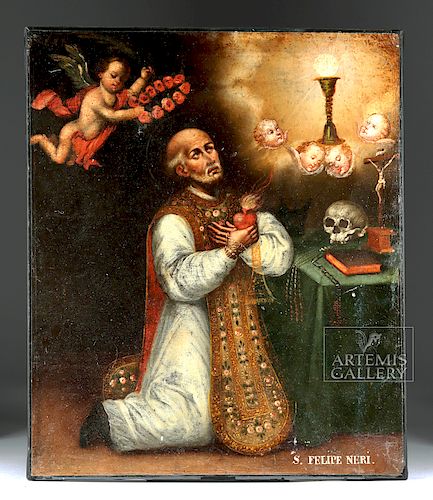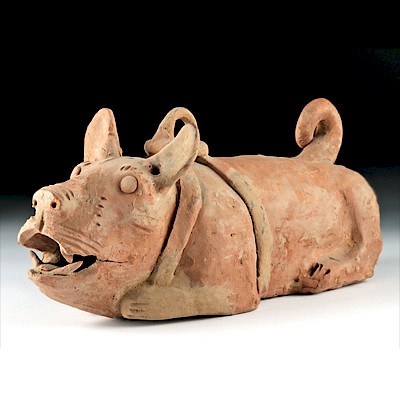18th C. Spanish Colonial Painting - San Felipe Neri
Lot 113
About Seller
Artemis Fine Arts
686 S Taylor Ave, Ste 106
Louisville, CO 80027
United States
Selling antiquities, ancient and ethnographic art online since 1993, Artemis Gallery specializes in Classical Antiquities (Egyptian, Greek, Roman, Near Eastern), Asian, Pre-Columbian, African / Tribal / Oceanographic art. Our extensive inventory includes pottery, stone, metal, wood, glass and textil...Read more
Estimate:
$3,000 - $5,000
Absentee vs Live bid
Two ways to bid:
- Leave a max absentee bid and the platform will bid on your behalf up to your maximum bid during the live auction.
- Bid live during the auction and your bids will be submitted real-time to the auctioneer.
Bid Increments
| Price | Bid Increment |
|---|---|
| $0 | $25 |
| $300 | $50 |
| $1,000 | $100 |
| $2,000 | $250 |
| $5,000 | $500 |
| $10,000 | $1,000 |
| $20,000 | $2,500 |
| $50,000 | $5,000 |
| $100,000 | $10,000 |
| $200,000 | $20,000 |
About Auction
By Artemis Fine Arts
Sep 13, 2018
Set Reminder
2018-09-13 10:00:00
2018-09-13 10:00:00
America/New_York
Bidsquare
Bidsquare : Ancient | Asian | Ethnographic - Fall Variety
https://www.bidsquare.com/auctions/artemis-gallery/ancient-asian-ethnographic---fall-variety-3432
Travel the world and back in time... Antiquities from Egypt, Greece, Italy and the Near East, Asian, Pre-Columbian, African / Tribal / Oceanic, Native American, Spanish Colonial, Russian Icons, Fine Art, much more! Artemis Fine Arts info@artemisfinearts.com
Travel the world and back in time... Antiquities from Egypt, Greece, Italy and the Near East, Asian, Pre-Columbian, African / Tribal / Oceanic, Native American, Spanish Colonial, Russian Icons, Fine Art, much more! Artemis Fine Arts info@artemisfinearts.com
- Lot Description
Spanish Colonial, Mexico, ca. 18th century CE. A fine oil on canvas painting depicting Saint Philip Neri, among the most revered religious leaders of 17th C. Rome whose reputation for having experienced a state of ecstasy while celebrating Mass informs this composition. Wearing a beautiful chasuble - the sleeveless outer vestment characteristically worn by a high priest when celebrating Mass - that is distinctly ornate, adorned by festoons of pink roses against a red and gold ground with extensive flourishes, San Felipe is kneeling in prayer and having a vision of the Crucifixion delineated in an orb of light upon a chalice surrounded by four seraphim, as a winged angel alights from the upper left, and is about to place a wreath of roses (symbolic of the Virgin Mary with whom Philip is also associated) on his head. The heart that St. Philip Neri holds is a reference to a heart condition said to have been brought about by his spiritual transport. This is also the source of his inscription, "Dilatasti cor meum," "When thou didst enlarge my heart" (Ps 118:32) Size: 24" L x 20.25" W (61 cm x 51.4 cm)
Beside the kneeling San Felipe is a table with rosary beads, a leather-bound Gospel, a Crucifix, and a momento mori skull. "S. FELIPE NERI" is delineated in rosy white on the lower right. In addition to the spiritual iconography of this piece, the artist's impassioned style is elevated by the use of tenebrism (tenebroso) displaying a dramatic use of light and shadow, clearly revealing a Baroque influence.
Philip Romolo Neri (Italian: Filippo Romolo Neri, 1515-1595) was an Italian priest best known as the founder of the Congregation of the Oratory, a secular clergy society. The son of a Florentine lawyer, Philip Neri studied theology in Rome, was ordained, and later founded a lay brotherhood devoted to charity work known as the Oratorians. Beloved for coming to the aid of the poor and ill, years later he was given the title of "Apostle of Rome". San Felipe Neri would become one of the most influential figures of the Counter-Reformation.
Philip Neri has been the subject of several famous artworks, including a painting by Guercino in 1656 and Tiepolo's painting depicting St. Philip Neri having a vision of the Virgin and Child with angels, a popular theme true to the spirit of the Counter Reformation. In Mexico, San Felipe had a major following during the Spanish Colonial period. The Temple of San Felipe Neri, also known as "La Profesa", is a Roman Catholic church that was consecrated in 1610. The brothers of the Oratory of Saint Philip Neri furnished the church with many paintings and artworks. Eventually some of the buildings became an art gallery housing the church's collection. One room named for Cardinal Newman housed paintings associated with the Oratory of Saint Philip Neri - including a series depicting the life of Saint Philip Neri by Antonio de Torres. (For more information, see Ruiz Gomar, Jose Rogelio, "The Paintings in La Profesa", Artes de México No. 172, Ciudad de México No. IX Tres Iglesias del Siglo XVIII (1973), pp. 89–91.) In addition, the Church of San Felipe Neri, erected in the 1730's and completed in 1803, features a central statue of Felippo Neri on the second register.
Provenance: private Santa Fe, New Mexico, USA collection
All items legal to buy/sell under U.S. Statute covering cultural patrimony Code 2600, CHAPTER 14, and are guaranteed to be as described or your money back.
A Certificate of Authenticity will accompany all winning bids.
We ship worldwide and handle all shipping in-house for your convenience.
#138164Canvas has been relined. New stretchers. There is a small puncture below the table - the verso of which is now covered since the canvas has been relined. There are a few small scratches (including below the flower wreath, to the left of the angel, on the white vestments covering his lower leg, to the upper right corner, among others) but they are relatively minor. Nice craquelure.Condition
- Shipping Info
-
All shipping is handled in-house for your convenience. Your invoice from Artemis Gallery will include shipping calculation instructions. If in doubt, please inquire BEFORE bidding for estimated shipping costs for individual items.
-
- Buyer's Premium



 EUR
EUR CAD
CAD AUD
AUD GBP
GBP MXN
MXN HKD
HKD CNY
CNY MYR
MYR SEK
SEK SGD
SGD CHF
CHF THB
THB














